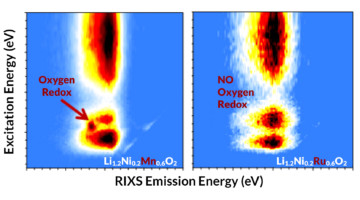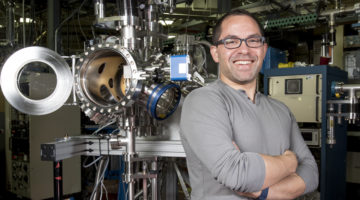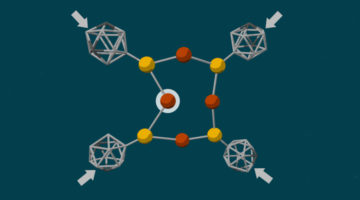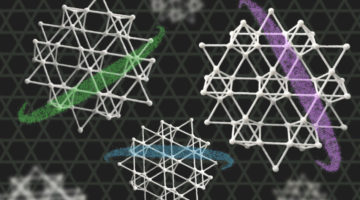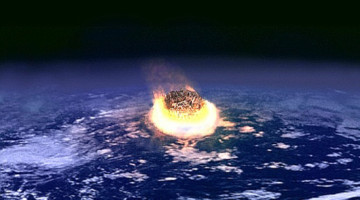As battery electrodes, layered transition-metal (TM) oxides demonstrate storage capacities far beyond what’s explained solely by TM redox activity. In this work, measurements of the lattice oxygen redox activity in two lithium-rich layered oxides showed strong oxygen redox when manganese was the TM, but not with ruthenium. Read more »
All News & Updates
2018 ALS User Meeting Award Nominations Due July 13
The ALS Users’ Executive Committee invites nominations from everyone – including students, postdocs, PIs, and staff – for the 2018 ALS User Meeting Awards. Consider preparing a nomination for a deserving colleague or group of individuals for one of the three awards. In addition to the award plaque, there will be a cash prize associated with each award. Read more »
Beamline Scientist Ethan Crumlin Receives DOE Early Career Award
Ethan Crumlin is one of six Berkeley Lab scientists selected by DOE’s Office of Science to receive Early Career Research Program awards. Crumlin’s award, for “Discovering the Mechanisms and Properties of Electrochemical Reactions at Solid/Liquid Interfaces,” will combine operando spectroscopy and microscopy techniques, modeling, and computation to gain insight into interactions between electrodes and electrolytes. Read more »
3D Localization of Nanoscale Battery Reactions
A new tool lets researchers pinpoint the locations of chemical reactions happening inside batteries in three dimensions at the nanoscale level. Combining ptychography, tomography, and spectroscopy, Nanosurveyor 1 is a multidimensional tool providing novel insight into the design of next-generation batteries and devices. Read more »
A facile route for the synthesis of heterogeneous crystal structures in hierarchical architectures with vacancy-driven defects via the oriented attachment growth mechanism
TiO2 nanorod arrays based on substrates with heterogeneous crystal structures and remarkable crystalline stability have potential as promising photocatalysts. Researchers synthesized a 1D anatase/rutile heterogeneous TiO2 crystal structure in a hierarchical architecture by forming hybrid organic–inorganic interfaces in a solution-based environment. Read more »
Molecular Anvils Trigger Chemical Reactions
“Molecular anvils” (diamondoids) were used to trigger chemical reactions using pressure, yielding products that differ from those produced in conventionally driven reactions with the same reactants. The discovery opens up new possibilities for the high-specificity synthesis of valuable but challenging molecules in an environmentally friendly process. Read more »![]()
![]()
The Electronic Structure of a “Kagome” Material
Scientists have verified exotic electronic properties predicted to emerge in a ferromagnetic material with “kagome” (trihexagonal) lattice symmetry. The greater understanding of kagome materials afforded by this work helps open up a new path toward goals such as ultralow-power electronic devices and quantum computing. Read more »![]()
![]()
From Moon Rocks to Space Dust: Berkeley Lab’s Extraterrestrial Research
Berkeley Lab has a well-storied expertise in exploring samples of extraterrestrial origin. This research—which has helped us to understand the makeup and origins of objects within and beyond our solar system—stems from long-standing core capabilities in structural and chemical analyses and measurement at the microscale and nanoscale. Read more »
Experiments at Berkeley Lab Help Trace Interstellar Dust Back to Solar System’s Formation
Experiments conducted at the Department of Energy’s Lawrence Berkeley National Laboratory (Berkeley Lab) helped to confirm that samples of interplanetary particles—collected from Earth’s upper atmosphere and believed to originate from comets—contain dust left over from the initial formation of the solar system. Read more »
Non-Crystal Clarity: Scientists Find Ordered Magnetic Patterns in Disordered Magnetic Material
Scientists have confirmed the presence chirality, or handedness, in nanometers-thick samples of amorphous (noncrystalline) multilayer materials. The chirality—which potentially could be exploited to transmit and store data in a new way—was observed in the domain walls between neighboring regions of opposite spin. Read more »
- « Previous Page
- 1
- …
- 93
- 94
- 95
- 96
- 97
- …
- 139
- Next Page »
